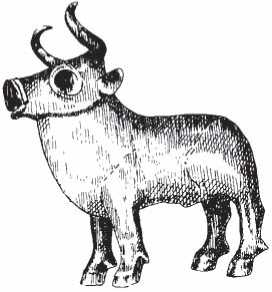'All the. . . country produces. . . every kind of livestock'.1 The domestication of farm animals by humans can be traced back, in parts of the Old World, to around 5000 BC.2 By the beginning of the Iron Age, in the eighth century BC, the peoples of temperate Europe had a diverse economy which included cereal and garden crops and the rearing of animals, particularly cattle, sheep, pigs and horses.3 This mixed farming has been a feature of many, ifnot most, of past European societies.4
There is no doubt that intensive husbandry of animals was practised in both Gaul and Britain during the Celtic Iron Age. The Celts were so good at stock-raising that the Greek geographer Strabo had occasion to comment: 'They have such enormous flocks of sheep and herds of swine that they afford a plenteous supply of sagi [woollen coats] and salt meat, not only to Rome but to most parts of Italy'.5 The vernacular sources of Ireland and Wales show us a Celtic society which relied on its cattle, sheep and pigs and in which a cow or a pig represented wealth.

Figure 2.1 Bronze figurine of a bull, sixth century BC, Byciskala Cave, Czechoslovakia. Height: 11.4cm. Paul Jenkins.
We have a problem in attempting to assess the stock-rearing aspect of farming during the Iron Age because almost all our information necessarily comes from bones, and these are notoriously difficult to interpret. For example, much bone waste from homes and farms has either been destroyed by acid soils or has been comminuted by the gnawing of dogs and pigs, with the result that the smaller, more fragile, bones of fish, chickens and very young animals have often vanished from the archaeological record.6 Again, there are very few good bone reports from modern excavations: none the less, in Britain we benefit from the exhaustive bone reclamation from Danebury (Hants) and Gussage All Saints (Dorset) and their careful respective analyses by Annie Grant and Ralph Harcourt. For northern France, the work of Patrice Meniel and Jean-Louis Brunaux has enhanced considerably our knowledge of Iron Age pastoral farming.
There is a peculiar relationship between humans and animals, a rapport born of the many features they have in common.7 Domestic animals lived and worked in a close and symbiotic association with humankind. They were tended, protected and fed but this caring was the means to a productive and profitable end - whatever was useful to humans. In a pastoral farming community, every part of an animal may be utilized: milk, wool, manure and muscle (for traction or transport) when it is alive; hides, meat, fat, blood, sinew and bone when it has been slaughtered.
There are certain general characteristics of Celtic domestic beasts and their use in Gaul and Britain. One is the small size of cattle, sheep, pigs and horses relative both to Roman strains and to present-day species. Larger, improved animals were present by the later Iron Age, possibly because of Roman influence but also perhaps because of better nutrition. At the time of the Roman occupation, both Gaul and Britain necessarily intensified their cereal production, giving cattle better fodder from the cereal waste and, at the same time, better pasture had been available by the later Iron Age because heavier soils, yielding lusher grass, were being exploited.8 A second feature of animal utilization has been the use of beasts in ritual activity (see chapter 5). A third is the very limited use made of wild animal resources for food (see chapter 3). Hunting was practised but was clearly not a significant source of food. An exception to this trend may have pertained at Val Camonica in northern Italy, where the evidence of the rock art - if it is a true reflection of daily life - suggests that stock-rearing played a very secondary role to hunting. But even here, pastoral farming clearly fulfilled the basic needs of the Celtic Camunians, for meat, eggs, dairy products, leather and wool.9 Some Iron Age sites used all the natural resources available to them: thus, at the Glastonbury lake village wading-birds and fish were caught, in addition to the raising of sheep for their meat and wool.10 Athenaeus tells us that the Celts who lived near water ate fish11 which they baked with salt and cumin.




 World History
World History









